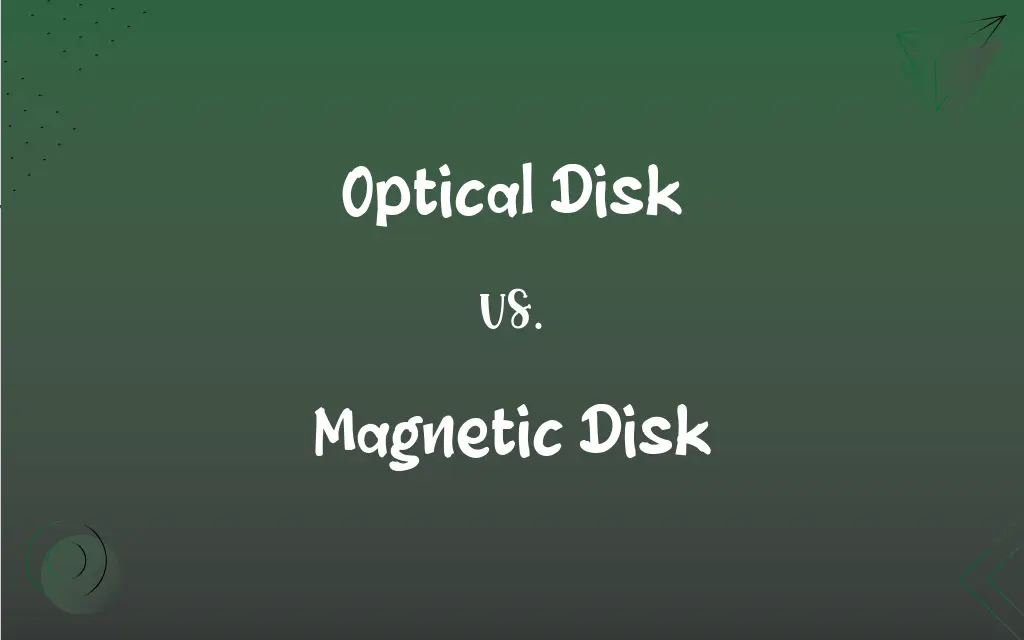Optical Disk vs. Magnetic Disk: What's the Difference?
Edited by Aimie Carlson || By Harlon Moss || Updated on October 4, 2023
Optical Disk stores data using laser beams, while Magnetic Disk stores data using magnetic fields.

Key Differences
Optical Disk and Magnetic Disk are both storage mediums, but they differ in their data recording methods. An Optical Disk uses lasers to read and write data, which is stored as pits and lands on the disk's surface. In contrast, a Magnetic Disk uses magnetic fields to read and write data on its spinning platter.
In terms of durability, Optical Disks can be less susceptible to environmental factors like heat and magnetism than Magnetic Disks. However, Magnetic Disks, due to their mechanical nature and moving parts, can be more prone to physical wear and tear compared to Optical Disks.
When considering storage capacity, Magnetic Disks, especially modern hard drives, generally offer larger storage space than most Optical Disks. For instance, while a standard DVD, an Optical Disk, might hold around 4.7 GB, a typical Magnetic Disk can store terabytes of data.
The speed of data access can differ between Optical Disk and Magnetic Disk. Magnetic Disks usually provide quicker data access and transfer rates than Optical Disks, making them suitable for tasks requiring rapid data retrieval, like running an operating system.
From a ubiquity standpoint, Magnetic Disks, found in hard drives, were traditionally used as primary storage in computers. Optical Disks, like CDs and DVDs, were popular for media distribution, but with the rise of streaming and cloud storage, their prominence has diminished.
ADVERTISEMENT
Comparison Chart
Data Recording Method
Uses lasers (pits and lands)
Uses magnetic fields
Durability
Less susceptible to heat and magnetism
Prone to wear and tear
Storage Capacity
Generally lower (e.g., 4.7 GB for a DVD)
Higher (up to several terabytes)
Data Access Speed
Typically slower
Faster, especially in hard drives
Primary Use
Media distribution (CDs, DVDs)
Main storage in computers (hard drives)
ADVERTISEMENT
Optical Disk and Magnetic Disk Definitions
Optical Disk
A medium that's less sensitive to environmental disruptions.
I store old photos on an Optical Disk to keep them safe.
Magnetic Disk
A device prone to mechanical wear over time.
My Magnetic Disk failed after several years of use.
Optical Disk
A disc where data is stored as light-sensitive pits.
Movies are often distributed on Optical Disks.
Magnetic Disk
A disc with a spinning platter for data storage.
I saved my documents on the Magnetic Disk.
Optical Disk
A storage medium read and written by lasers.
I burned my favorite songs onto an Optical Disk.
Magnetic Disk
A storage medium where data is stored via magnetism.
My computer's hard drive is a type of Magnetic Disk.
Optical Disk
A disc that uses reflective surfaces for data reading.
The computer reads the Optical Disk when it's inserted.
Magnetic Disk
The primary storage in most traditional computers.
The Magnetic Disk in my PC has a 1TB capacity.
Optical Disk
A storage device used mainly for media content.
Most old video games were sold on Optical Disks.
Magnetic Disk
A medium with faster data access speeds than optical variants.
Loading software from a Magnetic Disk is usually quicker.
FAQs
Is the floppy disk an Optical Disk?
No, the floppy disk is an older form of Magnetic Disk.
How do burning speeds affect the quality of data written on an Optical Disk?
Burning at slower speeds can lead to a more reliable write process for Optical Disks, reducing the chances of errors or unreadable sectors.
What are the risks of physical damage to a Magnetic Disk?
Dropping, jolts, or exposing the Magnetic Disk to extreme conditions can cause damage.
How long is the typical lifespan of an Optical Disk?
Under proper storage conditions, an Optical Disk can last several decades, though it varies based on the quality and type of disk.
Are Blu-ray discs a type of Optical Disk?
Yes, Blu-ray discs are a high-definition type of Optical Disk.
Why do Optical Disks sometimes fail to read in a player or drive?
Scratches, dirt, or defects on the disk surface can interfere with the laser's ability to read the data on an Optical Disk.
Why are Magnetic Disks sensitive to shocks and jolts?
The read/write heads in a Magnetic Disk hover extremely close to the spinning platters. Any sudden movement can cause them to collide, leading to potential damage.
Optical Disk or Magnetic Disk?
Magnetic Disk typically offers higher storage capacities than Optical Disk.
Can Optical Disks be used for computer backups?
While possible, Optical Disks have lower storage compared to Magnetic Disks, making the latter more suitable for backups.
Are CDs and DVDs types of Optical Disks?
Yes, both CDs and DVDs are examples of Optical Disks.
Are SSDs a type of Optical or Magnetic Disk?
Neither. SSDs (Solid State Drives) use flash memory, which is different from Optical or Magnetic storage methods.
Is data retrieval faster on an SSD compared to a Magnetic Disk?
Yes, SSDs generally offer faster data retrieval speeds than traditional Magnetic Disks due to the absence of moving parts.
Do Magnetic Disks require defragmentation?
Yes, traditional spinning Magnetic Disks can benefit from defragmentation to improve performance, though it's not necessary for SSDs.
Are there any risks associated with moving a device while a Magnetic Disk is in operation?
Yes, sudden movements can cause the read/write head to touch the spinning platter, risking damage or data loss.
Can Optical Disks be rewritten multiple times?
Some Optical Disks, like CD-RWs and DVD-RWs, can be rewritten, while others, like CD-R and DVD-R, are write-once.
Optical or Magnetic Disk?
Optical Disks, like DVDs and Blu-rays, have traditionally been used for movie distribution.
Can the data on an Optical Disk degrade over time?
Yes, while Optical Disks are durable, data can degrade over extended periods, especially if stored in unfavorable conditions.
Are Magnetic Disks affected by magnets?
Yes, strong magnets can corrupt data on a Magnetic Disk.
Can Magnetic Disks work in high-temperature environments?
Prolonged exposure to high temperatures can damage a Magnetic Disk, reducing its lifespan and potentially corrupting data.
How is data read on a Magnetic Disk?
A read/write head hovers above the spinning platter of the Magnetic Disk, accessing data using magnetism.
About Author
Written by
Harlon MossHarlon is a seasoned quality moderator and accomplished content writer for Difference Wiki. An alumnus of the prestigious University of California, he earned his degree in Computer Science. Leveraging his academic background, Harlon brings a meticulous and informed perspective to his work, ensuring content accuracy and excellence.
Edited by
Aimie CarlsonAimie Carlson, holding a master's degree in English literature, is a fervent English language enthusiast. She lends her writing talents to Difference Wiki, a prominent website that specializes in comparisons, offering readers insightful analyses that both captivate and inform.































































